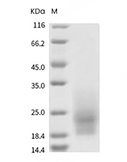Shopping Cart
- Remove All
 Your shopping cart is currently empty
Your shopping cart is currently empty
CD63 Protein, Human, Recombinant (His) is expressed in HEK293 mammalian cells with His tag. The predicted molecular weight is 13 kDa and the accession number is P08962-1.

| Pack Size | Price | Availability | Quantity |
|---|---|---|---|
| 5 μg | $48 | 7-10 days | |
| 10 μg | $75 | 7-10 days | |
| 20 μg | $118 | 7-10 days | |
| 50 μg | $229 | 7-10 days | |
| 100 μg | $386 | In Stock | |
| 200 μg | $682 | 7-10 days | |
| 500 μg | $1,430 | 7-10 days |
| Biological Activity | Activity testing is in progress. It is theoretically active, but we cannot guarantee it. If you require protein activity, we recommend choosing the eukaryotic expression version first. |
| Description | CD63 Protein, Human, Recombinant (His) is expressed in HEK293 mammalian cells with His tag. The predicted molecular weight is 13 kDa and the accession number is P08962-1. |
| Species | Human |
| Expression System | HEK293 Cells |
| Tag | C-His |
| Accession Number | P08962-1 |
| Synonyms | TSPAN30,OMA81H,MLA1,ME491,LAMP-3,CD63 molecule |
| Construction | A DNA sequence encoding the second extracellular domain of human CD63 (P08962-1) (Ala 103-Val 203) was fused with a polyhistidine tag at the C-terminus and a signal peptide at the N-terminus. Predicted N terminal: Ala 103 |
| Protein Purity | > 95 % as determined by SDS-PAGE  |
| Molecular Weight | 13 kDa (predicted); 22.8 kDa (reducing conditions) |
| Endotoxin | < 1.0 EU/μg of the protein as determined by the LAL method. |
| Formulation | Lyophilized from a solution filtered through a 0.22 μm filter, containing PBS, pH 7.4. Typically, a mixture containing 5% to 8% trehalose, mannitol, and 0.01% Tween 80 is incorporated as a protective agent before lyophilization. |
| Reconstitution | A Certificate of Analysis (CoA) containing reconstitution instructions is included with the products. Please refer to the CoA for detailed information. |
| Stability & Storage | It is recommended to store recombinant proteins at -20°C to -80°C for future use. Lyophilized powders can be stably stored for over 12 months, while liquid products can be stored for 6-12 months at -80°C. For reconstituted protein solutions, the solution can be stored at -20°C to -80°C for at least 3 months. Please avoid multiple freeze-thaw cycles and store products in aliquots. |
| Shipping | In general, Lyophilized powders are shipping with blue ice. |
| Research Background | The cluster of differentiation (CD) system is commonly used as cell markers in Immunophenotyping. Different kinds of cells in the immune system can be identified through the surface CD molecules which associating with the immune function of the cell. There are more than 320 CD unique clusters and subclusters have been identified. Some of the CD molecules serve as receptors or ligands important to the cell through initiating a signal cascade which then alter the behavior of the cell. Some CD proteins do not take part in cell signal process but have other functions such as cell adhesion. Cluster of differentiation 63 (CD63) is a member of the CD family and the transmembrane 4 superfamily, also known as the tetraspanin family. CD63 is a cell surface glycoprotein characterized by the presence of four hydrophobic domains. CD63 had functions in mediating signal transduction processes and then regulate a variety of cellular processes such as cell proliferation, activation and motility. It has been reported that CD63 protein associated with tumor progression and served as a blood platelet activation marker and the deficiency of this protein may be associated with Hermansky-Pudlak syndrome. |

Copyright © 2015-2025 TargetMol Chemicals Inc. All Rights Reserved.